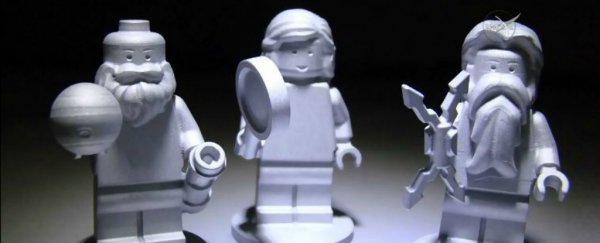After a five-year, 2.8 billion kilometre (1.7 billion mile) trip across the Solar System, the spacecraft Juno has just achieved "the hardest thing NASA's ever done" - putting the probe into orbit above Jupiter.
The US $1.1 billion trip at 265,000 kilometre per hour (164,663 mph) to the biggest planet in our Solar System set off from Florida in August 2011. It reached the most critical phase on 4 July, with a 35-minute engine burn, 869 million kilometers (540 million miles) from Earth, to place it in a 53.5-day orbit around the planet.
You can read more about this incredible achievement here.
While the 3.6-tonne (7,054-pound) solar-powered probe is unmanned, it does contain three 4-centimetre (1.5-inch) high Lego figures as part of an educational outreach program to inspire kids around the world about science and technology.
The trio are the 17th-century Italian astronomer and 'father of science' Galileo Galilei, the Roman god of sky and thunder, and king of gods, Jupiter, and his wife Juno (hence the spacecraft's name).
In 1610, Galileo - his Lego version holds a telescope - made the first detailed observations of Jupiter, discovering its four largest moons.
The planet, 300 times larger than Earth, also has 64 other moons, plus 'temporary' moons - comets captured by Jupiter's massive gravity.
Jupiter, holding lightning, was a rather naughty deity, who used clouds to hide what he was up to, but his wife Juno was always able to see through them - hence the magnifying glass of discovery in her Lego hand.
Lego made the figures especially for NASA out of space-grade aluminium to survive the trip and the highly radioactive, gaseous planet.
They've also done a whole space tie-in with NASA on their website.
Scientists are hoping that by studying Jupiter they'll better understand how Earth was formed.
The spacecraft will orbit Jupiter 33 times on its mission, skimming to within 5,000 km above the planet's cloud tops every 11 days, for approximately one year. When it's all over, they'll crash Juno into the planet in 2018. Perhaps, one day, human space explorers will find the three Lego people there.
Here's how things went for NASA today:
Success! Engine burn complete. #Juno is now orbiting #Jupiter, poised to unlock the planet's secrets. https://t.co/YFsOJ9YYb5
— NASA (@NASA) July 5, 2016
This article was originally published by Business Insider.
More from Business Insider:
